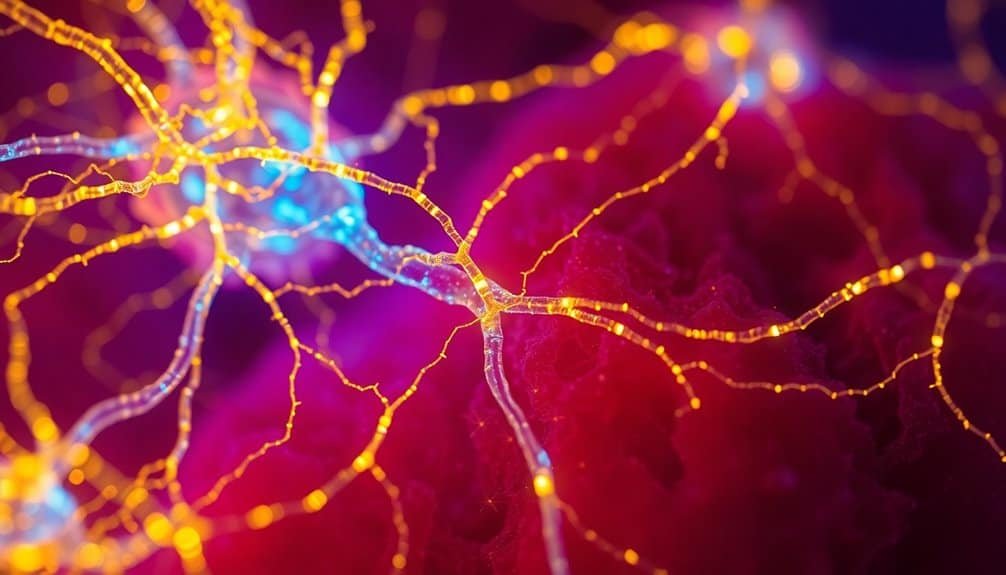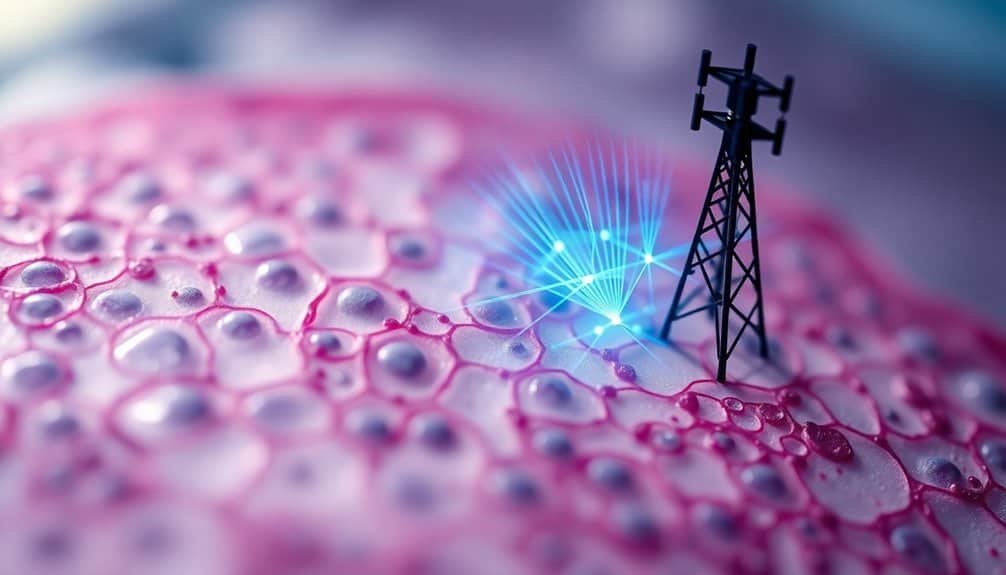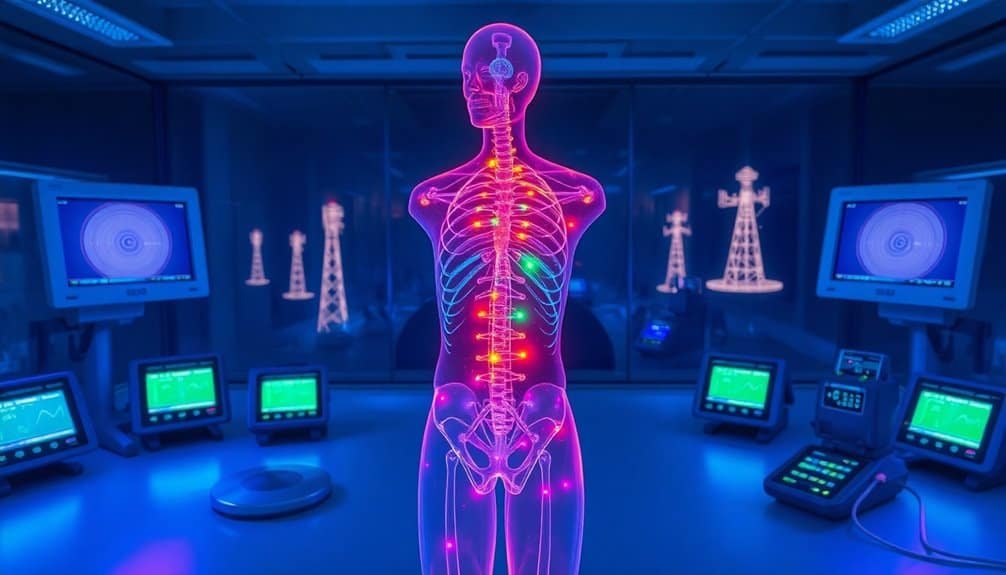Effects of 5G Radiation on the Human Body

5G radiation, emitting RF-EMF, raises health concerns like headaches, fatigue, and sleep disturbances, with some studies suggesting carcinogenic risks and increased cellular stress. Although typical exposure levels are within FCC safety limits, urban areas may experience higher levels.
Regulatory bodies such as ICNIRP provide guidelines for RF exposure. Further research is essential to fully understand these effects and uncover additional insights.
Disclaimer: As an affiliate, I may collect a share of sales from the links on this page.
Biological Effects of 5G Radiation

While you might be aware that 5G technology radiates radiofrequency electromagnetic fields (RF-EMF), it’s essential to understand its biological effects.
Studies suggest potential cancer risks from RF exposure, alongside increased cellular stress and harmful free radicals. You may notice concerns about genetic damages, though evidence remains mixed. IARC classified RF radiation as a ‘possible’ human carcinogen, which raises alarms regarding its safety. Additionally, increased permeability of the blood-brain barrier may occur with exposure, potentially leading to further health issues.
Some research indicates structural changes in cells but lacks consistent results regarding neurological effects. For example, while mice studies show altered protein expressions, behavioral impacts aren’t clear.
Understanding these biological mechanisms can help you evaluate the ongoing research and potential health implications of 5G technology.
Common Health Symptoms Linked to 5G Exposure
As awareness increases regarding the biological effects of 5G radiation, many individuals report a variety of health symptoms linked to exposure. These include increased concerns about cancer risk, with some studies suggesting a potential connection. Additionally, exposure may lead to cellular stress, raising free radical production in the body. Genetic damage is also a worry, though definitive evidence remains elusive. Neuropsychological effects, including altered brain function, are under investigation. Common complaints encompass headaches, fatigue, and sleep disturbances. It’s essential to recognize that these symptoms may vary widely and lack definitive causal links to 5G exposure at typical levels. Notably, international collaboration among diverse research fields aims to provide robust evidence on the potential health effects of 5G. Experts emphasize that non-ionizing radiation from 5G, which operates at low frequencies, is not proven to cause significant health issues under established safety guidelines.
Radiation Levels and Exposure Details

Recent studies have shown that typical 5G exposure levels around base stations are impressively low, often measuring between 0.0003% and 0.0082% of the Federal Communications Commission’s (FCC) maximum permissible exposure (MPE) limits. Measurement techniques utilize dual-polarized horn antennas and spectrum analyzers to assess these levels accurately. Urban areas typically experience higher exposure due to population density and network usage, while rural areas see lower figures. Exposure levels remain consistent with existing mobile networks at frequencies like 3.5 GHz, adhering to guidelines set by bodies such as ICNIRP and IEEE, ensuring public safety and regulatory compliance globally. Notably, 5G NR demonstrates high spectrum efficiency and advanced antenna technologies, resulting in lower RF EMF exposure levels compared to previous mobile network generations for similar services.
Research Findings on Health Risks
Emerging research highlights various health risks associated with 5G radiation, particularly concerning the biological effects of radiofrequency electromagnetic fields (RF-EMF).
Key findings include:
- Cancer Concerns: Some studies suggest RF exposure might be “possibly carcinogenic.”
- Oxidative Stress: Exposure may lead to oxidative stress, affecting cellular health.
- Cognitive Function: Research investigates potential impacts on cognitive functions, although definitive evidence is elusive.
While certain studies show no significant health risks in the general population, ongoing research is essential. Additionally, the classification of 5G and microwave radiation as non-ionizing radiation indicates that they cannot destroy electrons from atoms, yet they can still alter molecules and potentially damage cells.
Understanding these findings helps you assess the implications of 5G exposure on your health.
Regulatory Standards and Safety Measures

Regulatory standards and safety measures play an essential role in managing the health risks associated with 5G radiation. Organizations like ICNIRP set guidelines to limit RF exposure, updated to include more details for frequencies above 6 GHz. The WHO endorses these guidelines to protect public health.
Similarly, the FCC enforces specific absorption rate (SAR) limits to guarantee devices operate safely. Compliance is monitored rigorously, and educational initiatives aim to inform you about 5G safety.
Additionally, device designs and infrastructure placements are regulated to minimize RF exposure, focusing on public protection and aligning safety standards internationally.
Scientific Consensus and Ongoing Debate
While many studies indicate that low-level radiofrequency (RF) fields, such as those used in 5G networks, don’t pose significant health risks, the conversation remains contentious.
- Lack of Evidence: No confirmed dangers from 5G frequencies above 6 GHz exist.
- Exposure Levels: Public exposure stays below ICNIRP safety limits.
- Criticisms of Research: Many studies face methodological flaws, limiting their relevance.
Despite ongoing debates, the scientific consensus leans toward minimal health impact.
However, the need for long-term studies persists, with some calling for a cautious approach to address potential unknown effects fully.
Frequently Asked Questions
How Can I Minimize My Exposure to 5G Radiation?
You can minimize your exposure to 5G radiation by maintaining distance from towers, using EMF meters to identify high-radiation areas, employing shielding materials, and adopting safer device usage habits like using speakerphone or turning off devices at night.
Are Children More Vulnerable to 5G Radiation Effects?
Yes, children are more vulnerable to 5G radiation effects. Their thinner skulls and developing brains increase absorption rates, making them more susceptible to potential risks compared to adults, especially from prolonged exposure to wireless devices.
What Precautions Should Pregnant Women Take Regarding 5G?
To protect yourself during pregnancy, limit your exposure to 5G by keeping devices away from your body, reducing usage, using low EMF devices, and consulting with your healthcare provider for safer practices.
Can Protective Devices Reduce the Risks of 5G Radiation?
You might think protective devices always reduce risks, but they’ve mixed results. While some can block emissions, it’s safer to rely on guidelines and practice responsible device usage instead of depending solely on these products.
What Are the Long-Term Monitoring Plans for 5G Health Effects?
You’ll notice that long-term monitoring plans for 5G health effects involve ongoing studies evaluating cumulative exposure risks, collaboration among researchers and regulatory bodies, and regular updates to safety standards based on the latest scientific evidence.
Conclusion
Concerns about 5G radiation persist, but studies show minimal biological risk at regulated exposure levels. Safety standards are set by regulatory agencies based on extensive research to address public fears.
While some argue about potential long-term effects, the current scientific consensus is that 5G technology poses no significant harm to human health. Ongoing research will continue to monitor potential risks, ensuring that public safety remains a priority as telecommunications advance.






